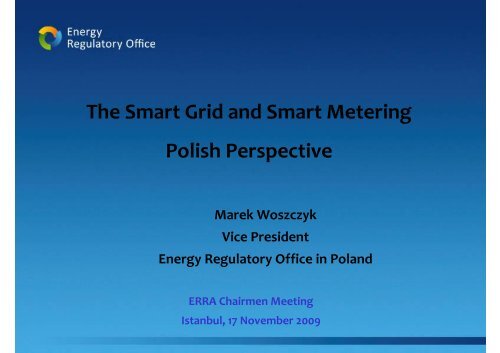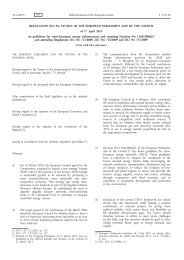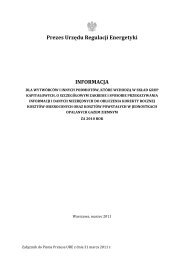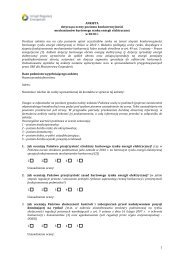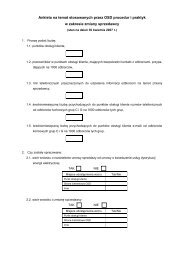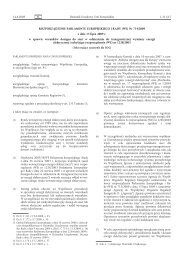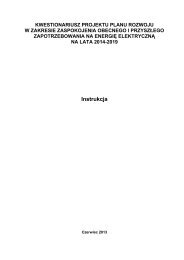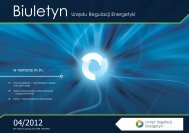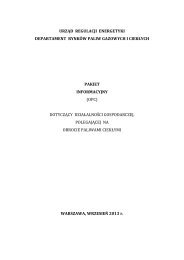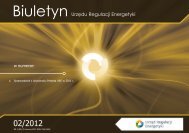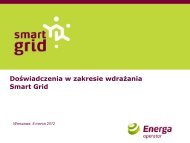The Smart Grid and Smart Metering Polish Perspective
The Smart Grid and Smart Metering Polish Perspective
The Smart Grid and Smart Metering Polish Perspective
- No tags were found...
You also want an ePaper? Increase the reach of your titles
YUMPU automatically turns print PDFs into web optimized ePapers that Google loves.
<strong>The</strong> <strong>Smart</strong> <strong>Grid</strong> <strong>and</strong> <strong>Smart</strong> <strong>Metering</strong><strong>Polish</strong> <strong>Perspective</strong>Marek WoszczykVice PresidentEnergy Regulatory Office in Pol<strong>and</strong>ERRA Chairmen MeetingIstanbul, 17 November 2009
1. Specific <strong>Polish</strong> situation• Current situation• Risks related to possible solutions• „<strong>Smart</strong>ness” related to EU law2. <strong>Smart</strong> <strong>Grid</strong>• Philosophy <strong>and</strong> <strong>Perspective</strong>s• <strong>Smart</strong> <strong>Grid</strong> as an „emergency exit” from current state3. <strong>Smart</strong> <strong>Metering</strong>• Definition• Cost / Benefits Analysis4. Regulatory activities• Feasibility Study• DeclarationHighlights
3Current situation <strong>and</strong> the nearest future of the <strong>Polish</strong> energy sectorfrom technical point of view‐ ‐ Structure of power plants ( geographical distribution <strong>and</strong> coaldominance )‐ ‐ Average age of power plantsSpecific <strong>Polish</strong> situation‐ ‐ Reduction of current margin of power dynamic reserve in the system‐ ‐ Unsteady generation diffusion inside the network (on the medium<strong>and</strong> low voltage levels) – massive investment as a condition ofconnection, increase of dispatching problems‐ ‐ Increasing of imbalance between geographical distribution of load<strong>and</strong> generation‐ ‐ Insufficient transmission <strong>and</strong> distribution capabilityAccording to traditional manner, we must build (or rebuild) massivestructures in generation <strong>and</strong> network areasAll above mentioned kinds of investment have to be realised during a veryshort time because of expected power imbalance, with all negative priceconsequencesThis picture is not too optimistic already, but legal influence on the futurewill make it much more complex
Risks related to possible solutions in the traditional mannerCoal: ‐ economical risk of continuity of current technologies <strong>and</strong> locations forgeneration (new kind of str<strong>and</strong>ed costs)social risk regarding the reduction of coal mining‐ according to EU law – necessity to CCT development (CCS for example)Natural gas:‐ political risk regarding increased dependency of power production from gas dueto one‐direction suppliesNuclear:‐ social risk because of the „Czernobyl trauma”Biomass:risk of competition to the food market‐ risk of environment degradation (overload of forest biomass exploitation <strong>and</strong>total ineffectiveness of reduction of deposit of CO2 according to current legalrules, focused on co‐burning in large power plants)Wind:risk of overinvestment on network‐ risk of system disturbances because of instability of wind powerOther renewable sources:‐ limited possibility to solve system problems because of small scale ofapplications4Specific <strong>Polish</strong> situation
Specific <strong>Polish</strong> situationRisks related to possible solutions in the traditionalmanner is not only <strong>Polish</strong> problem, it is commonsituation of many European countries, UK forexample:„…With gas too risky, coal too dirty, nuclear too slow<strong>and</strong> renewables too unreliable, Britain (similar likePol<strong>and</strong>) is in a bind. …”„…All this leaves Britain in a hole. <strong>The</strong> lights aredimming, but green targets are an argument against newcoal plants, security-of-supply concerns make gas dicey,lack of time rules out nuclear, <strong>and</strong> worries aboutpracticality dog renewables.…”[both above: <strong>The</strong> Economist , Aug 6th, 2009]5
„<strong>Smart</strong>ness” related to EU law<strong>The</strong> 3 x 20 Package of EC:‐ necessity to decrease of CO2 emission ‐ switch off abig part of generation (fit jet) in 2016, due toemission limits (deep decreasing of power systembalance) perspective‐ necessity of development of renewable generation,specially wind farms on‐shore <strong>and</strong> off‐shore‐ necessity of improving energy efficiency (decreasinglosses f.e.)<strong>The</strong> III Liberalisation Package of EC the useful tool torealise targets above mentioned6
<strong>Smart</strong> <strong>Grid</strong> Philosophy
<strong>Smart</strong> <strong>Grid</strong> PhilosophyEU Technology Platform <strong>Smart</strong> <strong>Grid</strong>swww.smartgrids.eu
<strong>Smart</strong> <strong>Grid</strong> <strong>Perspective</strong>sCash flow imp.Networkmaintenance& planningoptimisationFlowcontrolOutagesmanagementLossesreduction…?…?…?…?Anti-blackblack’outmethodologyAMIVirtual Power PlantDistributedGenerationRESActive Dem<strong>and</strong>Response &ProsumersE - homeEnergyefficiencyimprovementE - mobility
<strong>Smart</strong> <strong>Grid</strong> as an emergency exit<strong>The</strong> first step to a <strong>Smart</strong> <strong>Grid</strong> is <strong>Smart</strong> <strong>Metering</strong>10What means „the <strong>Smart</strong> <strong>Metering</strong>”:‐ dual side flow of information‐ real time (if necessary) of measuring <strong>and</strong> informationcollecting<strong>and</strong> exchange‐ three levels of needed meters’ deployment :‐ inside a grid‐ at the delivery points (on the borders of a certainDOS’s grids)‐ at all customers <strong>and</strong> other system users
<strong>Smart</strong> <strong>Metering</strong> DefinitionWytwórcacentralnyOSD (inny) Obrót OSP RegulatorAMR: one –directioncommunicationOSPrepozytorium centralneAplikacjeanalityczne Komunikator: WYArchiwum centralneKomunikator: WETelekomAMM: dual –directioncommunicationOSDrepozytoriumlokalne OSDKoncentratorPLCOperator GPS/GPRSGPS/GPRS, RFCzłonWykonawczyKomunikatordedykowanyterminalPC odbiorcyAMI: AMM fullintegrated withentity’s IT toolsodbiorcaLicznikPamięć lokalnalokalne żródłoenergiisprzęt AGD
<strong>Smart</strong> <strong>Metering</strong> Costs/Benefits Analysis[M€]151050-5-10roll’out during 5 yearsMulti meterscenarioProduction benefitsDistribution benefitsDistribution costsRetailers benefitsCustomers benefitsZa: Oliver Huet, EDF R&D, <strong>Smart</strong> <strong>Metering</strong> technologies: a fast moving frontier; Florence School of Regulation, 06/02/09,(Important it is reverse of typical situation: externalisation internalities)12
<strong>Smart</strong> <strong>Metering</strong> Costs/Benefits AnalysisDSObenefitsdividing13
<strong>Smart</strong> <strong>Metering</strong> Costs/Benefits AnalysisAMM total investment (with home terminals) :on LV:~7,5 mld PLNon MV <strong>and</strong> HV (75% of energy market):~70 mln PLNIndividual AMM investment:‐ on MV <strong>and</strong> HV ~ 2,5 tys PLN/unit‐ on LV ~470 PLN/unit14[According Transition Facility PL2005/017‐488.02.04]
<strong>Smart</strong> <strong>Metering</strong> Costs/Benefits AnalysisNon activity alternative:(Effectsceteris paribus passive scenario)Additional new expenditures areasLoss benefits areagenerationnetworktimeCO2 allowancescostsPunishment forabove limitemissionStr<strong>and</strong>edcompetivenesscosts of economy…Non deliveredenergy costsStr<strong>and</strong>edinvestment costsPunishment forunsufficient QoSMore frequenttraditional mannerreading costs…1515
<strong>Smart</strong> <strong>Metering</strong> Costs/Benefits AnalysisAgreeing development plans <strong>and</strong> tariff approval as a tool of investmentfinancingCUSTOMER COSTSApproval scheme (roll’out effects):new network tariffprevious network tariffnet benefitTrade benefitCUSTOMER BENEFITSt16
Regulatory activitiesFeasibility study:Transition Facility PL2005/017‐488.02.04Title: „Reinforcing the regulatory supervision ofthe energy sector”, component 1.Time: January –July 2008Product: Four reports:1. Technical report2. Cost report3. Legal report4. Social‐economic reportFirst public presentation of results – December200817
Reglatory activitiesDeclaration concerning the introduction of smart metering intothe <strong>Polish</strong> power system:Warsaw, 3 June 2009signed by Presidents / Chairmen of:Energy Regulatory Office,Consumers’ Federation,<strong>Polish</strong> Consumers’ Association,<strong>The</strong> <strong>Polish</strong> National Energy Conservation Agency,Consumers’ Forum for Electricity <strong>and</strong> GasMany other bodies (administrative, academic <strong>and</strong> business) sendaccess will18
Thank you for your attention


